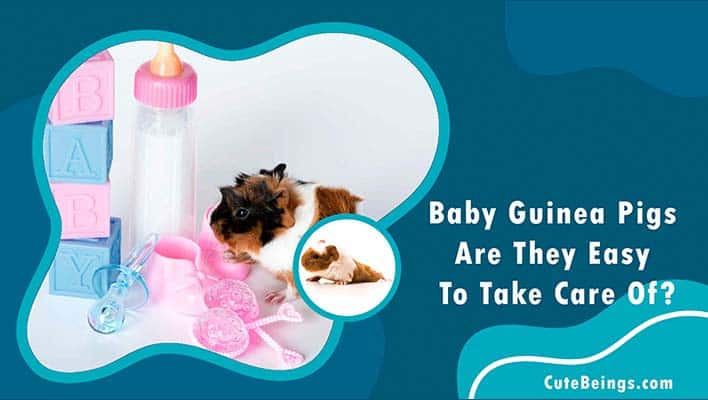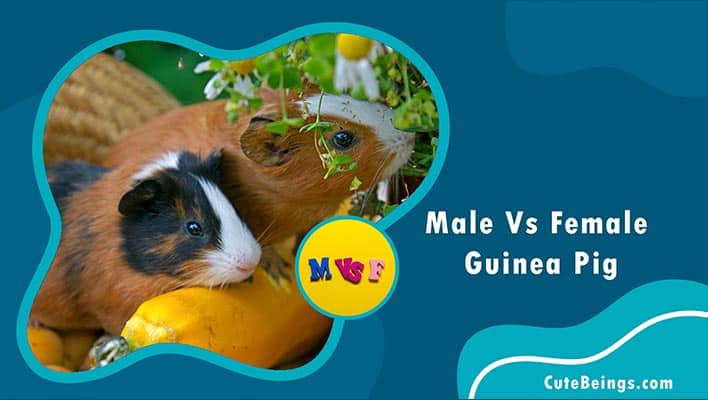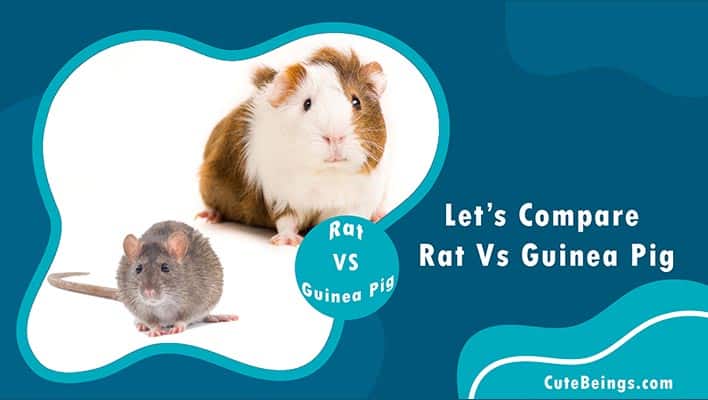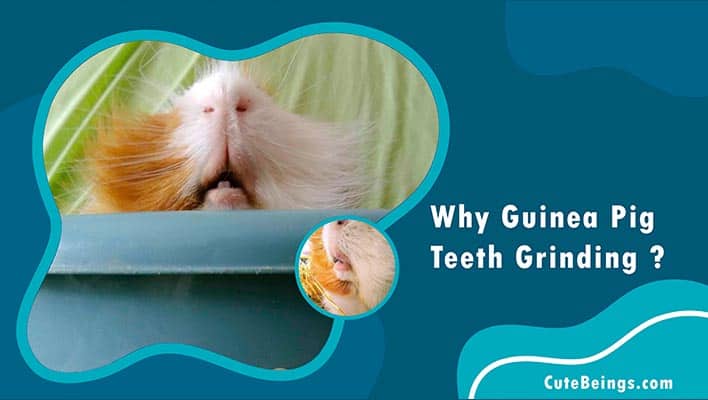Baby guinea pigs are usually known as pups and 50g to 100g or 1.75 to 3.5 ounces in weight. You might think this size is very small for social animals but they are born with furry coat, teeth, hearing and with vision. They can crawl short after birth and they would walk and groom themselves within a day or so.
With skinny pigs you won’t find a furry coat when they are born but just like other guinea pigs they have full set of teeth and opened eyes. You need not to worry about a newborn guinea pig but observe whether mother guinea pig is keeping it warm specially a skinny pig as they don’t have fur to keep them warm.
Normally a guinea pig mother does not search for her baby guinea pig because a baby guinea pig is able to consume or nibble on solids from day 2 as it has teeth. Mother will let her guinea pig babies to nurse. She will keep licking pups for about 2 to 3 weeks to help with defecation and urination after they are born. Further nursing will continue for another few weeks.
Table of Contents
Baby Guinea Pig Foods
Baby guinea pigs should have kept with its mother until the weaning period is completed as newborn babies will nurse for roughly 3 to 6 weeks and until they can eat independently. Weaning period can affected by several things such as number of babies, mother’s milk supply and pup’s weight.
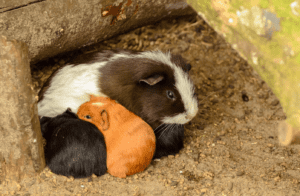
As nursing will gradually finish, you need to start feeding timothy hay to both mother and the babies. Unlike other rodent types, Cavia porcellus rodents are born precocial. As a pup finishes weaning period, guinea pig owners can consider and treat a young guinea pig as an adult guinea pig.
Guinea pig mothers will produce a special kind of fecal stool after they give birth which can be consumed by guinea pig babies. If you see newborns eat fecal pellets don’t be too excited as this is a completely normal behavior among guinea pigs.
👉 Important
-
Guinea pig mother will clean the newborns and consume after giving birth. She does that to chemically produce the mammary glands to begin generating milk. This is also similar to humans as human moms take a day or two to produce milk.
-
Avoid feeding cow’s milk or milky foods which contain cow’s milk to guinea pig babies.
-
Never overfeed your pet guinea pig. Just like humans providing fewer large meals won’t do any good for your domestic guinea pig. Feed several small meals which would be better in long run. If you notice any formula comes out from nostrils that mean the liquid has most likely gone into lungs. This is some serious health condition as your small pet would develop pneumonia and face a life ending threat.
-
Guinea pig pups will always take a long time to eat so you need to have patience.
-
When young cavies are hungry they will make a sound like human young children. Pups will make a chirping sound to let you know that they are ready to eat or to tell you “hello I am hungry”
Things You Should Do When Guinea Pig Mother Fails To Feed Newborns
Sometimes mothers won’t be able to feed their babies due to various difficulties. When some mothers may not be able to produce milk others may not care for their newborns.
In these situations all the responsibility comes right onto you to take care of one or all newborn pups. Now you are aware that they have particular dietary needs. So act wisely and try following these methods to increase the probability of survival for the newborns and to face this challenge strongly.
Assisted feeding
You need to try natural feeding before commencing bottle feeding or syringe feeding. You can help out the newborns to natural feeding. Check the condition of the mother guinea pig and if she is not too stressed, you can firmly hold the mother with your hands and try putting each pup gently to the nipples you babies can self-feed. It may be helpful to pups if there is small quantity of milk on the nipple to attract to suckle.
Fostering
If your mother guinea pig can’t feed its babies or in a situation she dies you need to look for alternatives to feed the newborn babies. If you happen to have another mother who can milk the babies by any chance you can try convincing that sow to adopt the new babies and that is known as fostering.
Before you try fostering, be aware of the age of orphans and other guinea pig babies who are fed by the foster mother. If the mother has a small litter of piglets as the same age as orphans that would be fantastic. The reason is older guinea pig babies will push the younger ones away from the mother so that makes it very difficult for orphans to suckle.
In worst case scenario orphans could starve and lose weight dramatically.
If you have few mothers with a litter you can split the orphan babies among them and that could make fostering successful. In rodents, guinea pigs are different when it comes to adoption as females would help raising newborns even they didn’t give birth to those pups. They usually adopt the baby guinea pigs of others.
Easy steps for fostering,
-
Before fostering commences you need take out foster mother and keep her separate in a cage with water and plenty of food.
-
Then place orphan babies with foster mother’s ones in a box with the bedding material used in the foster mother’s cage.
-
You can keep them around 20 to 30 minutes together and that will help all of them to smell same so adoptive mother will think they all are her pups.
-
Now you can place foster mother back in her cage and slowly and carefully introduce the orphan pups.
-
Observe their behavior closely and if you notice any aggressive actions against the orphans pups remove them quickly and place them again with foster mother’s piglets to a box for another 20 minutes and then try again introducing.
-
If you notice the mother pushes away the orphans that simply mean she is neglecting them. Here you need to push the orphans towards the mother and ultimately she would accept them and let them to suckle.
-
Even after this, if sow is rejecting pups spread some mentholated vapor on all babies including the adoptive mother’s ones. Then apply some on the chin of the mother as well. This will hide the difference of the odor among pups so she can’t tell them apart. Then introduce them to the mother and she would accept all the babies on her cage.
-
After she admits the orphans she will allow them suckle. Observe them for about an hour to make sure that there is no aggressive behavior among them.
-
Do not leave the babies alone with the mother until you can come to conclusion that she will nurse orphan pups. It is essential for newborns to receive the colostrum which is an important substance that contains nutrition and antibodies through mother’s milk as their first meal. Pups need this substance during the first week of life and since after one week newborns can be hand raised. One week old pup has a great chance of survival.
If any of these methods don’t work for you then responsibility comes on your shoulder to raise them. So you need to commence assist feeding or hand-raising.
Hand-Raising Newborns
In case you don’t have any foster guinea pig mothers, you will have to hand-raise the orphan newborns by yourself. It’s not an easy task but you will have to take care your little cavies. Even you do a perfect job with lot of hard work, patience still a newborn cavy who is less than one week old could die.
If you don’t have a foster option you need to make up your mind for a difficult challenge with long sleepless nights. Though you work hard the survival rate will be very less if you have to hand-raise a pup.
Emergency Foods For Baby Guinea Pigs
Here are some food measures which can be adjusted according to your need and your vet can prescribe you formulas to buy from pet store. When you face an emergency, use this as a starter until you seek advice from your veterinarian.
-
5ml or .17oz of water
-
20g or .71oz of alfalfa hay based crushed pellet powder
-
Butternut squash baby food or cooked pumpkin
-
Alfalfa powder and guinea pig milk alternative formula (this is optional)
Keep your timing noted as it is not a good thing that these pups go too long between their meals. They would start suckling each other when they are too hungry. This can cause various health issues such as prolapsed of the rectum.
Feeding Process
You need to avoid accidental inhalation of the formula you provide to babies. Even a small drop of formula can lead to lethal pneumonia within a short period.
Follow these methods to carefully feed you pup,
-
It is best to purchase a 1ml or .0034 oz syringe to feed your pup. If you don’t have previous experience about syringe feeding you should not use bigger syringe than 1ml.
-
Wash thoroughly all your syringes, bottles and teaspoons before feeding and remove any needle if the syringe has one.
-
Newborns are impulsive and fidgety. They would jump without prior warning so make sure they are in a safe environment to feed.
-
Take the pup to one hand in usual sitting position and take the syringe or the bottle to other hand. You can also keep the pup on a table or on the floor in a sitting position and then you can feed with your syringe or bottle in a slightly vertical angle in front.
-
You need to have patience when you feed them. If the babies reject feeding or refuse the syringe wet its lips with a drop of warm formula. After the pup swallows that repeat it few more times. Be gentle always. Gradually the baby will learn about the feeding and the feeding time and will not make any problems when you feed later.
-
Do not force your baby or do not grasp too much formula to its mouth as they can inhale the formula quickly. Squeeze the drops slowly so the pup can lick them up.
-
If your baby suckles well allow your pup to do it in its own way. Do not add any extra pressure on yourself or the feeding. They have enough strength to empty the bottle or the syringe without you helping to it. In case of extra force, the formula will come fast and the baby guinea pig might accidently aspirate the formula.
-
If your piglet does not suckle don’t consider as a major issue. Most babies would learn to sip or lap from the teat. This can be considered as safer as it reduces the risk of the aspiration. Hold the teat of the bottle or the tip of the syringe down-pointed or sideways. This will further reduce the risk of aspiration.
It will be a good thing if you can weigh your babies daily as the amount of milk which should be fed depends on the babies’ body weight. So find or purchase a small scale if possible.
Keep notes on the body weight or weight gain and food consumption on your babies. Usually the frequency of feeding them matters on the quantity which baby guinea pigs take in one feeding session.
👉 Important: Most cavy babies will consume milk through syringe or teaspoon without an issue. In day time feed babies every 2 to 3 hours time and in night feed them every 4 to 5 hours.
In Addition To Feeding
You might already know that guinea babies need the stimulation from their mother to release urine and to defecate after meals. Guinea pig mother uses its tongue to groom the babies and this stimulation on babies belly and in genital region helps pups to do its task.
So for orphan babies you need to perform this stimulation. To impersonate this stimulation you can use a cotton ball which is dampened from warm water. Gently rub the cotton ball on urogenital area until the baby release the steam of urine. This would take 15 to 20 seconds or more.
Do Baby Guinea Pigs Need Warm Atmosphere?
If your guinea pig babies are totally abundant by the mother that means not just having a mother who rejects to allow babies to suckle, those babies can quickly become cold. As they are away from their mother’s furry coat it is good to keep them in a warm quiet place, in a carry cage or a box.
If you have two or more babies they would snuggle with each other to keep them warm. But if you have one baby you need provide a warm water bottle or a heat pack covered from a soft towel as a heating source as your baby find it too hot it can move to an isolated area where the floor is not heated.
Avoid using heat lamps as they could cause burns and dehydrate your pet if it is kept too close to pups.
Taking Care Of Baby Guinea Pigs
When you are handling pups wash your hands thoroughly before you touch them. Washing hands will remove any possible bacteria and any other odors from animal or objects which can stress the pups. After you wash them rub your hands with some clean fresh hay and on mother’s furry coat to have a familiar odor.
Then you can pick them up and check to make sure that they are doing fine. After keep them again with their mom so they can build up a good bond. You need to wait till your guinea pig is 2 to 3 weeks old because that is the period they tend to develop a bond with humans and they won’t show any discomfort when you hold them.
You need to begin handling the babies as sow will let you do it. By doing so, they will become friendly with humans. Though you will have to face issues with other rodent types when you handle the babies, with cavies you won’t have any issue as the mothers will accept their pups even after you handle them.
When you are getting closer to a baby, reach in a way as it can see you coming closer. Also do it slowly and in a gently manner. Hold them under their belly and from their bottom keep holding them close to you.
Do Male And Female Guinea Pigs Need To Be Separated?
When breeding guinea pigs you might know that you need to separate to boar soon after mother give birth to babies otherwise you will end up with a pregnant guinea pig again. Male guinea pigs don’t play a role in raising the babies so there is no need to keep them in the same cage with baby guinea pigs.
After the feeding period is over you need to separate the male guinea pigs to avoid guinea pig pregnancy from their mother as they could be mating with their mother or other female guinea pig in the guinea pig cage. They are concerned as sexual maturity animals as they finish their weaning period.
At What Age Can Baby Guinea Pigs Be Re-Home?
Guinea pig babies can be introduced to new families or re-home as they are eight weeks old. Make sure they can eat solids by themselves before you do so.
Do Guinea Pig Mothers Eat Or Harm Their Pups?
Unfortunately yes, mothers do eat newborns very rarely. This unfortunate situation can be avoided and makes it easy to avoid if the biological reasons are identified behind this phenomenon. Usually there are two main reasons for this occurrence.
-
Starvation
This can occur even to an experienced mother. A mother could eat its babies when she is badly malnourished and your sow doesn’t need to be thin for this to happen. When she doesn’t get enough nourishment from the diet she can still be malnourished even though she receives sufficient calories to preserve her needs and body weight.
-
Immaturity
Guinea pig mother could accidentally damage its babies with teeth while she tries to groom them up after giving birth. Inexperience causes this and this usually occurs when newborns are not responding to her attention. When pups don’t respond because they are ill or for other reason sow tries to clean them again and again forcefully. Then she ends up hurting them ultimately.
Frequently Asked Questions (FAQ)
Do Guinea Pigs Eat Their Babies If You Touch Them?
No, guinea pigs do not eat their babies when you touch them. There is myth in the society about this but it is completely false. No harm is done when you touch a baby or an adult guinea pig.
Do Baby Guinea Pigs Drink Water?
Baby guinea pigs will drink mother’s milk first and eventually they will drink water only.
How Often Do Baby Guinea Pigs Drink Water?
Usually guinea pigs consume 50ml to 300ml of water daily. You need to provide clean and fresh water to your cavy.
How Do You Give A Baby Guinea Pig Water?
Hold the water bottle in a low position so the baby guinea pig can reach easily and drink from the bottle. You may need to watch closely and adjust the height of the bottle you are holding few times as you need to make it comfortable to your baby guinea pig.
Do Baby Guinea Pigs Eat Straight Away?
Though baby guinea pigs can digest solid foods soon after they are born, they will look for milk every two hours from their mother. Babies need to be nursed and do not rush things as you want it.
When Can You Hold A Baby Guinea Pig?
You need to handle baby guinea pigs very gently and you should not hold a baby at least the baby is one week old. They are fragile as they do not have strong bones. If you handle them carelessly you could harm them and that could be fatal to them.
What Kind Of Milk Do You Feed A Baby Guinea Pig?
The best milk you can feed is guinea pig mother’s milk. If you have an orphan try giving full fat goat’s milk or you can mix half of water to half evaporated milk. Then soak a piece of brown bread in milk and feed this to your pup on a tea spoon. Pup will suck the milk out from bread piece. This can be listed second in the list when mother’s milk makes the top of the list.
What Is Imprinting?
Imprinting can be described as a young animal builds up a close bond with a fellow mate. Normally baby animals most of times imprint on their mother as she is one they see after the birth, hear, smell and be familiar with. They always depend on their mother’s protection. They tend to follow her footsteps and same nature applies to the cavies.
If you are hand-raising a pup, it will imprint on you. Pup will build up a close bond with you your caring will make them gentle loving pets. They will always look for your visits and they will identify you quickly. Also they will love when you cuddle them.
Further Reading
Do you have an interest in Hamsters? Here are some articles written by our writers to keep you up to date on other pets.
- https://cutebeings.com/why-do-hamsters-eat-their-babies
- https://cutebeings.com/can-hamsters-eat-cheese
- https://cutebeings.com/hamster-wet-tail
- https://cutebeings.com/hamster-sand-bath
- https://cutebeings.com/bunny-harness/

Hello, my name is James and I’ve been caring for tiny pets for over 14 years with a passion. I enjoy passing on my expertise to other individuals in order for them to have the same amount of enjoyment as I do.

